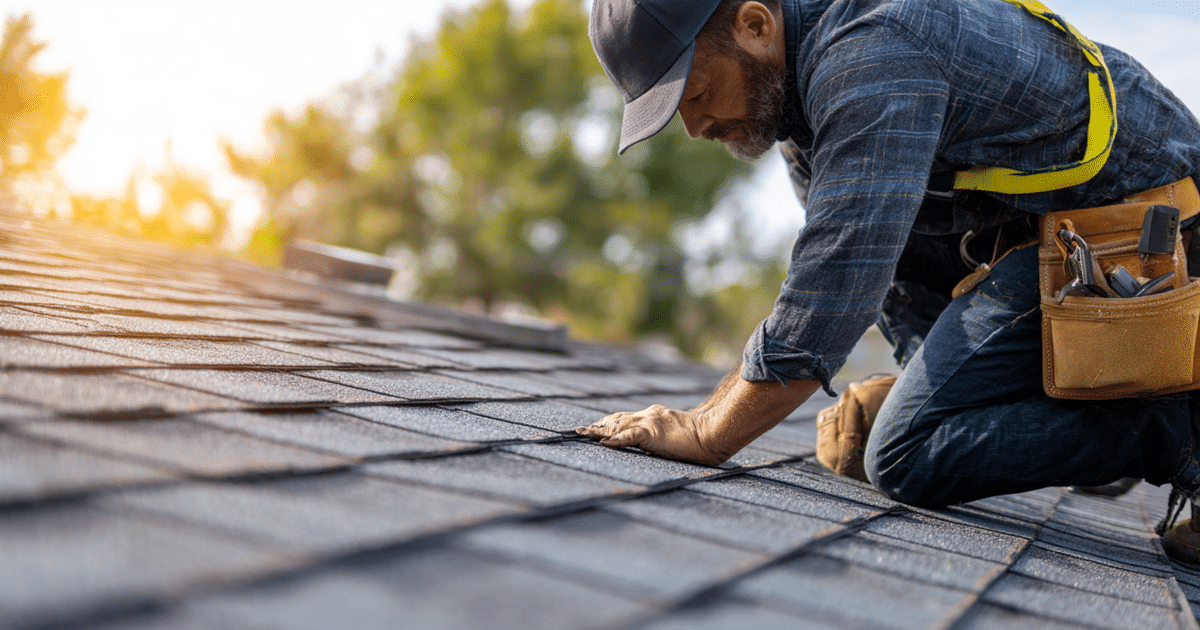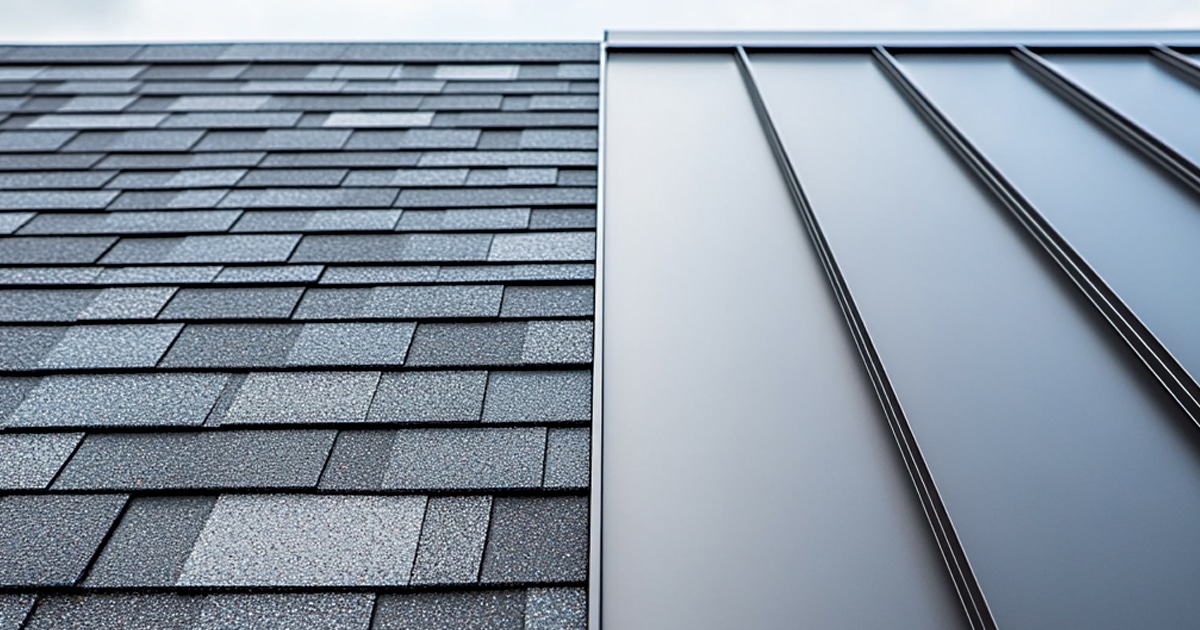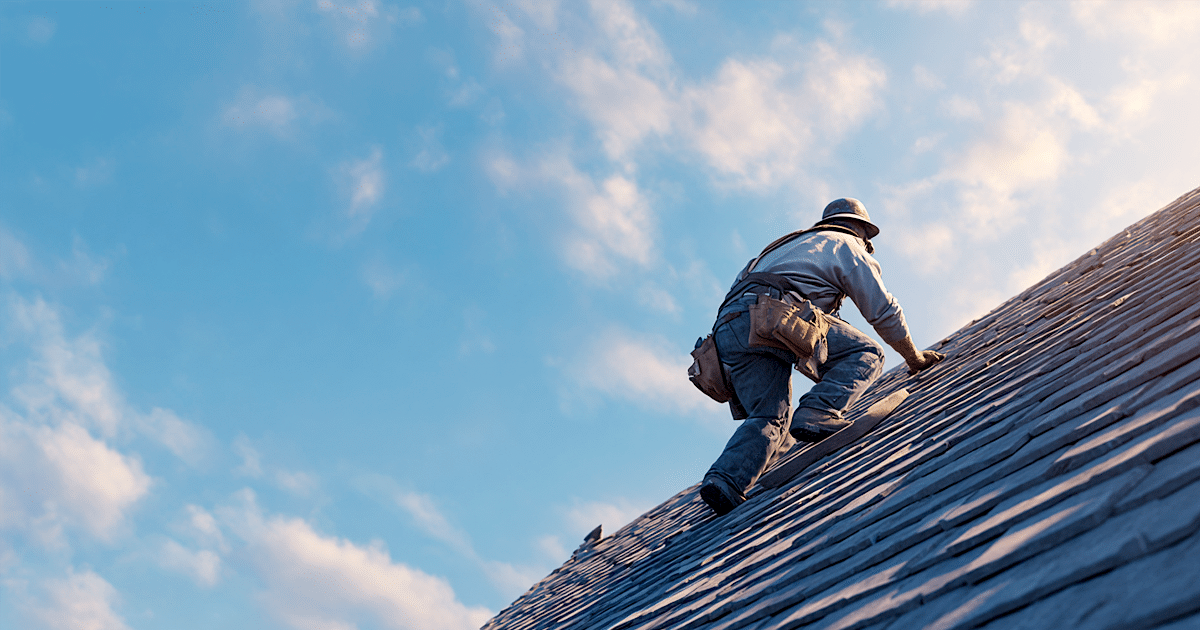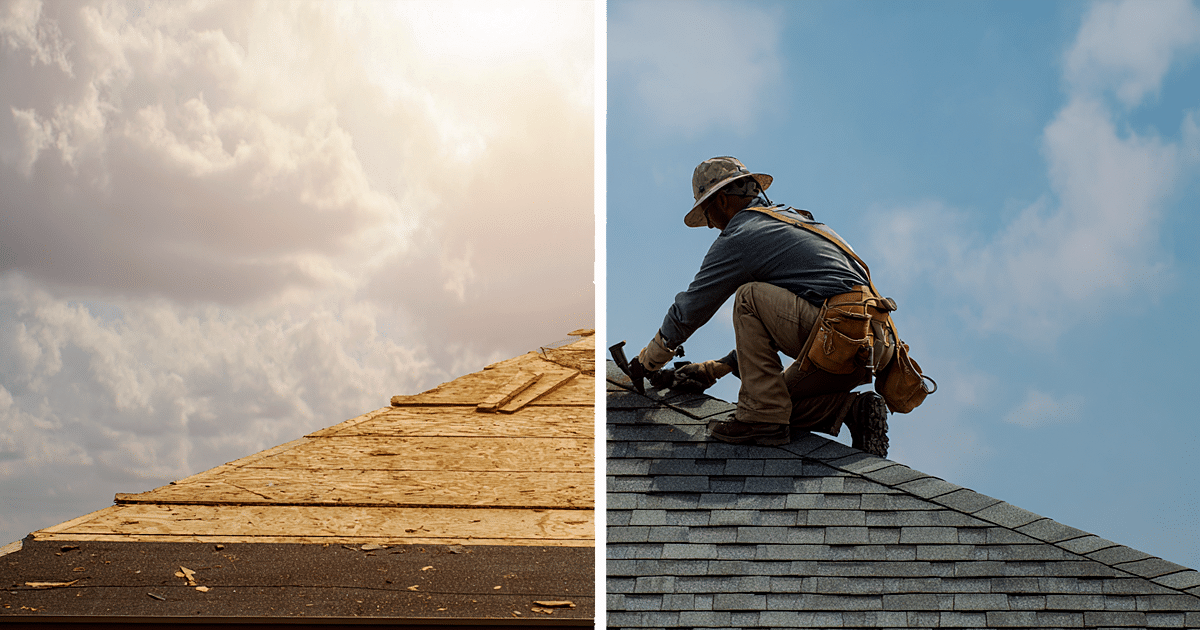Everyone loves to save money, but cheap roofing can end up being one of the most expensive decisions a homeowner makes. A low bid often means corners are being cut somewhere—whether it’s with thinner shingles, untrained labor, or skipped underlayment that no one sees until it’s too late. What looks like a deal at first can quickly lead to leaks, water damage, and repairs that cost far more than doing the job right the first time. In Texas weather, a roof built on shortcuts won’t stand a chance for long. Investing in quality materials and workmanship protects more than your budget—it protects your home.
Key Takeaways
- Low-bid roofing contractors often use substandard materials that fail within 5-10 years instead of lasting 20-30 years
- Cheap roofing can cost 40-60% more long-term due to premature replacement, leak repairs, and interior damage
- Unlicensed contractors offering rock-bottom prices may void manufacturer warranties and leave homeowners without recourse
- Hidden costs in low bids frequently include change orders that can increase final project costs by 25-50%
- Quality roofing contractors provide detailed estimates, proper licensofiing, and comprehensive warranties that protect your investment
When faced with roofing estimates ranging from $8,000 to $25,000, choosing the lowest bid seems like smart financial planning. After all, a roof is a roof, right? Unfortunately, this mindset leads many homeowners into what industry experts call the “cheap roofing trap” – where initial savings transform into costly long-term expenses that can double or triple the original investment.
The roofing industry has documented countless cases where homeowners who thought they were saving money upfront ended up paying significantly more over time. According to the National Roofing Contractors Association, roofs installed by low-cost contractors have a 30% higher failure rate than those completed by reputable contractors using quality materials and proper installation techniques.
Understanding the real cost of cheap roofing requires looking beyond the initial estimate. From subpar materials that fail prematurely to hidden fees that surface mid-project, the lowest bid often becomes the most expensive mistake a homeowner can make. This comprehensive analysis will reveal why quality roofing services, while more expensive initially, provide better long-term value and peace of mind.

Why Homeowners Fall for the Lowest Bid Trap
Roof replacement represents one of the largest home maintenance expenses, typically ranging from $8,000-25,000 depending on size, materials, and regional labor costs. When many homeowners receive roofing estimates from different contractors, the price variations can be staggering – sometimes differing by thousands of dollars for what appears to be the same work.
Multiple bids can vary by thousands of dollars, making the lowest option seem financially smart, especially when household budgets are tight. The psychological appeal of saving money upfront often overshadows concerns about long-term performance or contractor reliability. Many homeowners focus solely on upfront costs without considering long-term value and protection, treating their roof like a commodity rather than a critical building system.
Aggressive marketing from storm-chasing contractors often emphasizes “limited-time” low pricing that creates artificial urgency. These roofing companies frequently appear after severe weather events, going door-to-door with promises of insurance claim assistance and rock bottom prices. Their high-pressure sales tactics exploit homeowners’ desire to save money while addressing urgent repair needs.
Economic pressures and tight budgets make cheap roofing bids appear like necessary compromises. When facing unexpected roof replacement costs, many homeowners convince themselves that a cheaper option will “do the job” until they can afford something better. However, this approach rarely works as planned, often resulting in complete roof replacement within just a few years.
The proliferation of online reviews and comparison shopping has also contributed to the problem. Homeowners may see positive reviews for cheap roofers without understanding that these reviews often come immediately after installation, before long-term problems become apparent. The best value in roofing becomes clear only after several years of performance testing through various weather conditions. For tips to avoid roofing scams, be sure to look for company credentials and comprehensive reviews.
Substandard Materials: The Foundation of Failure
Low-bid roofing contractors frequently use inferior materials to keep material costs down while maintaining profit margins. The most common cost-cutting measure involves using basic 3-tab shingles instead of architectural shingles, reducing lifespan by 5-10 years. While 3-tab shingles may look adequate initially, they lack the dimensional stability and weather resistance of higher-grade asphalt shingles.
Cheap shingles often use lower-quality asphalt and fewer granules, making them more susceptible to cracking, curling, and granule loss. These low quality materials may cost 30-40% less than premium materials, but their reduced lifespan means homeowners face frequent repairs and earlier replacement. The manufacturer’s warranty on cheap shingles typically covers only material defects, not performance issues related to inferior composition.
Underlayment represents another area where cheap roofers cut corners. Instead of synthetic underlayment that can withstand extended UV exposure and provides superior water resistance, low roofing bid contractors often use basic 15-pound felt paper. This subpar material breaks down quickly when exposed to moisture and temperature fluctuations, creating leak-prone areas throughout the roofing system.
Inferior fasteners like standard nails instead of ring-shank nails compromise wind resistance ratings and void manufacturer warranties. Quality roofers use galvanized or stainless steel fasteners that resist corrosion and provide superior holding power. Cheap roofers may use whatever fasteners are least expensive, regardless of their suitability for local climate conditions or building requirements.
Off-brand or discontinued materials may lack manufacturer support and warranty coverage, leaving homeowners without recourse when problems develop. These roofing materials often come with limited technical support and may not meet current building codes or insurance requirements. Poor-quality flashing materials corrode quickly, leading to leak-prone areas around chimneys, vents, and other roof penetrations.

Climate-Specific Material Failures
Regional climate conditions expose the inadequacies of low grade materials more quickly than moderate environments. Cheap asphalt shingles crack and curl in temperatures above 100°F common in southern states, creating gaps that allow water infiltration and reduce energy efficiency. The thermal cycling from extreme heat during the day to cooler nighttime temperatures causes cheaper materials to expand and contract beyond their design limits.
Low-grade materials lack proper algae resistance, causing unsightly streaking within 2-3 years that requires costly cleaning or premature replacement. This algae growth, also known as Gloeocapsa magma, not only affects appearance but can also reduce the roof’s reflective properties and increase cooling costs. Quality materials include copper granules or other algae-resistant treatments that maintain their appearance for decades.
Inadequate ice and water shield in northern climates leads to ice dam damage and interior repairs that can cost thousands of dollars. Cheap roofers often skimp on this critical component or use inferior products that fail when ice dams form. The resulting water infiltration can damage insulation, drywall, flooring, and even structural components.
Substandard ventilation components fail to prevent moisture buildup and reduce energy efficiency throughout the home. Poor ventilation leads to premature deterioration of all roofing materials, ice dam formation in winter, and increased cooling costs in summer. The resulting moisture problems can also lead to mold growth and structural damage that extends far beyond the roofing system itself.
Workmanship Shortcuts That Cause Expensive Problems
The quality of installation often matters more than the materials themselves, and this is where cheap roofing companies typically cut the most corners. Rushed installation schedules that complete jobs in 1 day versus the industry-standard 2-3 days increase error rates significantly and compromise long term performance. When roofing contractors prioritize speed over quality, critical installation steps get skipped or performed incorrectly.
Improper nail placement outside manufacturer specifications voids shingle warranties and creates immediate failure points. Each asphalt shingle has a specific nailing zone where fasteners must be placed to ensure proper wind resistance and weather sealing. Cheap roofers often use nail guns set at incorrect pressures or install nails too high, too low, or at wrong angles, compromising the entire roofing system’s integrity.
Skipped starter strips and drip edge allow wind uplift and water penetration that leads to premature shingle failure and interior damage. These components, while relatively inexpensive, play critical roles in protecting the roof’s perimeter. Poor workmanship in these areas often becomes apparent during the first major storm, when shingles blow off or water infiltrates around the roof’s edges.
Inadequate flashing around penetrations creates immediate leak points that worsen over time, often requiring expensive interior repairs in addition to roof remediation. Proper flashing installation requires careful attention to detail and understanding of how water flows around roof obstacles. Cheap roofing contractors may use inadequate materials, install flashing incorrectly, or skip this step entirely to save time and material costs.
Poor ventilation installation reduces attic airflow, causing premature material degradation and increased energy costs. Proper roof ventilation requires calculating the correct balance of intake and exhaust vents based on attic square footage and roof design. Cheap installations often feature inadequate ventilation or improperly placed vents that don’t create the necessary airflow patterns.
The Real Cost of Labor Shortcuts
When reputable roofing contractor standards aren’t followed, the consequences extend far beyond the roof itself. Water damage from poor flashing can cost $3,000-8,000 in interior repairs including drywall, insulation, and flooring replacement. These costs often aren’t covered by standard homeowner’s insurance if the damage results from poor installation rather than a covered peril like storm damage.
Improper installation leads to ice dams causing $5,000-15,000 in structural damage when ice and water back up under shingles and into the home’s interior. Ice dams form when warm air from inadequately ventilated attics melts snow on the roof, which then refreezes at the colder eaves. The resulting ice buildup forces water under shingles and into the home’s structure.
Mold growth from chronic leaks averages $10,000-30,000 in remediation costs depending on the affected area and duration of moisture exposure. Mold can begin growing within 24-48 hours of water intrusion and quickly spreads throughout building materials. Professional mold remediation requires specialized equipment and techniques that make it far more expensive than preventing leaks in the first place.
Energy costs increase 15-25% due to poor attic ventilation and insulation damage caused by moisture infiltration. When roofing systems don’t perform properly, heating and cooling systems must work harder to maintain comfortable indoor temperatures. These increased utility costs compound over time, often totalling thousands of dollars over the life of a poorly installed roof.
One of the most frustrating aspects of cheap roofing bids involves discovering that the low initial estimate doesn’t include essential components or services. Low bids often exclude permit fees ($100-500), disposal costs ($300-800), and code upgrades required by local building departments. These disposal fees can add significant cost to projects, especially when multiple layers of old roofing materials must be removed and properly disposed of.
Change orders for “discovered” issues like rotten decking can add $2,000-5,000 to project costs, often doubling the original estimate. While some structural problems can only be identified after removing old materials, disreputable contractors may deliberately underestimate these issues to secure contracts with artificially low bids. The resulting change orders often carry premium pricing since homeowners have few alternatives once work has begun.
Missing components like ridge vents, gutters, or fascia boards appear as additional charges mid-project when homeowners assume these items were included in the original estimate. Quality roofing contractors provide detailed written estimates that specify exactly what materials and services are included. Cheap contractors often provide vague estimates that leave room for numerous add-on charges throughout the project.
Labor overruns due to weather delays or complications result in unexpected daily fees that weren’t disclosed in the original contract. While weather delays are sometimes unavoidable, professional contractors typically include contingency planning and communicate clearly about how such delays will be handled. Cheap contractors may use weather delays as opportunities to extend projects and increase costs.
Cleanup and debris removal may not be included in low bids, leaving homeowners with disposal responsibilities and potential safety hazards around their property. Professional roofing work generates substantial debris that requires proper disposal and site cleanup. Homeowners may find themselves paying additional fees for dumpster rental and debris hauling that should have been included in the original estimate.
Bait-and-Switch Tactics
Unscrupulous roofing companies often employ bait-and-switch tactics that start with unrealistically low initial estimates. These initial low estimates are based on “minimum requirements” with pressure to upgrade during installation when cheaper materials prove inadequate. Once work begins, contractors claim that building codes or structural conditions require more expensive materials or additional work not included in the original estimate.
Verbal promises not included in written contracts create disputes over scope and pricing that favor contractors rather than homeowners. Many homeowners accept verbal assurances about included services or material quality without ensuring these promises appear in written contracts. When disputes arise, contractors can claim that additional services were never part of the original agreement.
Material substitutions after contract signing due to “supply issues” or “quality improvements” often result in inferior products or higher costs. Some contractors deliberately specify materials they don’t intend to use, planning to substitute cheaper alternatives during installation. Others may claim that “upgraded” materials are necessary for proper installation, charging premium prices for standard components.
Additional fees for standard practices like moving outdoor furniture or protecting landscaping can add hundreds of dollars to project costs. Professional contractors typically include these basic services in their estimates, understanding that proper site preparation and protection are essential parts of quality workmanship. Cheap contractors may charge separately for each of these services, nickel-and-diming homeowners throughout the project.
Insurance and Licensing Risks
Working with unlicensed contractors creates legal and financial risks that extend far beyond poor workmanship. Unlicensed contractors cannot legally obtain building permits, potentially creating code violations that prevent home sales or refinancing. When building departments discover unpermitted work, homeowners may face stop-work orders, fines, and requirements to tear out and replace work that doesn’t meet current codes.
Lack of proper insurance leaves homeowners liable for worker injuries or property damage that can result in lawsuits and substantial financial judgments. Workers’ compensation gaps can result in $50,000+ medical claims against homeowner policies when uninsured workers are injured on the property. Most homeowner’s insurance policies specifically exclude coverage for injuries to uninsured contractors, leaving property owners fully liable.
Uninsured contractors may disappear after accidents, leaving homeowners facing lawsuits from injured workers or their families. Even minor injuries can result in substantial medical bills and lost wages that become the homeowner’s responsibility when contractors lack proper insurance coverage. The legal costs of defending against such claims often exceed the original savings from choosing a cheaper contractor.
Improper installation voids manufacturer warranties, eliminating coverage for material defects and leaving homeowners responsible for all future repairs and replacement costs. Most roofing material manufacturers require installation by certified contractors following specific procedures to maintain warranty coverage. When cheap roofers don’t follow these requirements, expensive material failures become the homeowner’s financial responsibility.

Legal and Financial Consequences
Building code violations from unlicensed work can prevent home sales or refinancing until corrective work is completed at the homeowner’s expense. Real estate transactions often require building department inspections that can uncover unpermitted or substandard work. Buyers may demand credits or repairs, while lenders may refuse to finance properties with code violations or unpermitted improvements.
Insurance claims may be denied if roof failure results from unpermitted or improper installation rather than covered perils like storm damage. Insurance adjusters are trained to identify substandard work and may deny claims for water damage or other issues that result from poor installation. This leaves homeowners responsible for both repair costs and potential liability for damage to neighboring properties.
Homeowners may face stop-work orders and fines from local building departments when unpermitted work is discovered during routine inspections or complaint investigations. These enforcement actions can halt projects mid-completion and require expensive corrective work before normal construction can resume. The costs of bringing work up to code often exceed the original project budget.
Legal recourse against fly-by-night contractors is often impossible due to dissolved business entities, false contact information, or contractors who operate across state lines. Many cheap roofing companies disappear when problems arise, leaving homeowners with no practical way to recover damages or force completion of warranty work. The legal costs of pursuing such contractors often exceed any potential recovery.
Long-Term Financial Impact Analysis
Understanding the true cost of cheap roofing requires analyzing expenses over the entire lifecycle of the roofing system. Quality roofing lasting 25-30 years costs approximately $0.50-0.75 per square foot annually when total project costs are divided by expected lifespan. This calculation includes initial installation, routine maintenance, and expected repairs over the roof’s useful life.
Cheap roofing requiring replacement every 10-15 years costs $1.00-1.50 per square foot annually, making it significantly more expensive despite lower upfront costs. This analysis becomes even more dramatic when factoring in inflation, as future roof replacement costs will be substantially higher than today’s prices. Homeowners who choose cheap roofing often find themselves facing replacement costs when they can least afford them.
Emergency repairs during storms cost 2-3 times normal rates due to high demand and urgent circumstances. When cheap roofs fail during severe weather, homeowners often have no choice but to pay premium prices for emergency tarping and temporary repairs. These emergency costs can quickly exceed the original savings from choosing a low roofing bid.
Poor roofing reduces home value by 5-10% and creates red flags during property inspections that can complicate sales transactions. Real estate appraisers and home inspectors can identify substandard roofing that affects property values and marketability. Potential buyers may demand credits, request repairs, or simply choose other properties rather than inherit roofing problems.
Energy inefficiency from inadequate installation increases utility costs by $200-600 annually due to poor insulation performance and inadequate ventilation. When roofing systems don’t perform as designed, heating and cooling systems must compensate for the deficiencies. These ongoing utility cost increases continue throughout the roof’s shortened lifespan.
Real-World Cost Comparison
A practical example illustrates the true cost difference between quality and cheap roofing over time. A $12,000 quality roof lasting 25 years costs $480 per year, while an $8,000 cheap roof replaced twice in 20 years totals $16,000 plus inflation adjustments on the second replacement. When factoring in 3% annual inflation, the second roof replacement might cost $12,000-14,000, bringing total costs to $20,000-22,000.
Additional repair costs for cheap roofing average $2,000-4,000 over the first 10 years as substandard materials and poor workmanship create ongoing problems. These repairs disrupt household routines, require time off work for contractor access, and often provide only temporary solutions that need repeating. The cumulative stress and inconvenience of frequent repairs adds hidden costs that are difficult to quantify.
Interior damage from failed cheap roofing can exceed original roof cost by 50-100% when water infiltration damages flooring, drywall, insulation, and personal belongings. A $10,000 cheap roof that fails and causes $15,000 in interior damage represents a total loss of $25,000 compared to a $15,000 quality roof that protects the home’s interior for decades.
Lost equity and marketability issues compound financial losses over time as poor roofing affects the home’s value and appeal to potential buyers. Homes with obvious roofing problems often sit on the market longer and sell for less than comparable properties with quality roofing systems. The carrying costs of extended marketing periods add to the total financial impact of cheap roofing decisions.
How to Evaluate Roofing Bids Properly
Proper evaluation of roofing quotes requires more than comparing bottom-line prices. Homeowners must understand what each estimate includes and excludes to make meaningful comparisons. Request detailed material specifications including brand names, grades, and warranty information for all components. Quality contractors provide comprehensive estimates that specify exactly which materials will be used, from shingles and underlayment to flashing and fasteners.
Verify contractor licensing through state databases and check Better Business Bureau ratings to ensure you’re working with legitimate businesses. Most states maintain online databases where homeowners can verify contractor licenses, check for complaints, and review any disciplinary actions. The Better Business Bureau provides additional information about business practices and customer satisfaction records.
Obtain proof of general liability insurance and workers’ compensation coverage before allowing any work to begin on your property. Request certificates of insurance directly from the contractor’s insurance company rather than accepting photocopies that may be outdated or fraudulent. Verify that coverage amounts meet local requirements and that policies will remain in effect throughout your project.
Compare scope of work line-by-line to ensure all bids include identical services and materials. Different contractors may include or exclude various services like permit acquisition, debris removal, or site protection. Create a standardized comparison chart that lists each component and service to identify which bids are truly comparable.
Check references from jobs completed 2-5 years ago to assess long-term satisfaction and performance rather than relying only on recent testimonials. Recent references may not reveal long-term problems that take time to develop. Older references provide insight into how well the roof has performed and whether the contractor stood behind their work when issues arose.
Red Flags to Avoid
Several warning signs indicate contractors who should be avoided regardless of their pricing. Door-to-door solicitation with high-pressure sales tactics and “today only” pricing represents a major red flag, especially after storm events. Legitimate contractors rarely need to solicit business door-to-door and don’t use high-pressure tactics to force immediate decisions.
Requests for full payment upfront or cash-only transactions indicate potential fraud or financial instability. Professional contractors typically request modest down payments with progress payments tied to completion milestones. Cash-only requests may indicate attempts to avoid taxes or create no paper trail for accountability.
Significant price differences (more than 30%) between comparable bids without clear explanations suggest either unrealistic estimates or plans to add charges later. While prices can vary based on materials and methods, extreme differences usually indicate that estimates aren’t truly comparable or that hidden costs will appear during construction.
Reluctance to provide references, licensing information, or detailed material specifications suggests contractors with something to hide. Professional contractors are proud of their work and readily provide references and credentials. Evasive responses to basic questions about licensing and insurance should disqualify contractors from consideration.
Questions to Ask Potential Contractors
Smart homeowners ask specific questions that reveal contractor knowledge and professionalism. What specific brands and grades of materials will be used for shingles, underlayment, and flashing? Quality contractors can explain material choices and their benefits rather than providing vague descriptions.
How long have you been in business at your current location with the same business name? Established contractors with stable business operations are more likely to be available for warranty service and have track records that can be verified. Be wary of contractors who frequently change business names or locations.
Can you provide references from similar projects completed in the last 2-3 years? Recent references demonstrate ongoing business operations and current work quality. Ask for references from projects similar in scope and complexity to your own rather than accepting generic testimonials.
What warranty coverage do you provide for materials and workmanship separately? Understanding warranty terms helps evaluate long-term value and contractor confidence in their work. Quality contractors provide comprehensive warranties that cover both materials and labor for extended periods.
How do you handle change orders and unexpected issues discovered during installation? Professional contractors have clear procedures for communicating and pricing unforeseen work. Understanding these procedures helps avoid disputes and surprise charges during construction.

FAQ
How much should I expect quality roofing to cost compared to the lowest bid?
Quality roofing typically costs 20-40% more than rock-bottom bids but provides 2-3 times longer lifespan and better protection. The total cost of ownership is usually 30-50% lower when factoring in longevity, repairs, and energy efficiency. For example, a quality roof costing $15,000 that lasts 25 years provides better value than a $10,000 roof that needs replacement every 12 years. When you consider the costs of premature replacement, frequent repairs, and potential interior damage, investing in quality roofing services upfront saves money significantly over time.
What happens if my cheap roof fails and the contractor is no longer in business?
Homeowners are typically responsible for all repair and replacement costs with no recourse when contractors disappear. This scenario is common with storm-chasing contractors who operate seasonally or fly-by-night operations that dissolve when problems arise. Without a stable business entity to hold accountable, homeowners must pay for all corrective work out of pocket. Additionally, manufacturer warranties may be void if the original installation didn’t meet specifications, leaving homeowners without coverage for material defects. Always verify business stability and local presence before hiring any roofing company.
Can I save money by getting a cheap roof and upgrading later?
This approach usually costs significantly more than doing it right initially and represents a common but expensive mistake. Roof replacement requires complete tear-off and disposal of existing materials, plus potential repairs to damaged decking or structure that may have occurred due to poor initial installation. The labor costs alone for a second full roof replacement often exceed the savings from the original cheap installation. Additionally, interior damage from a failing cheap roof can cost thousands in repairs that could have been avoided with proper initial installation. Quality roofing installation from the start provides better long-term value and avoids the disruption and expense of premature replacement.
How can I tell if a roofing bid is legitimately competitive versus dangerously cheap?
Legitimate competitive bids typically fall within 10-20% of each other when comparing identical materials and scope of work. Bids that are 30% or more below others often indicate corner-cutting, inferior materials, or missing components that will appear as change orders during construction. To evaluate bids properly, ensure all estimates include the same materials, services, and warranties. Ask for detailed material specifications and verify that permits, disposal, and cleanup are included. Be particularly suspicious of bids that seem too good to be true, as they usually involve hidden costs or substandard work that becomes apparent only after problems develop.
What should I do if I discover problems with cheap roofing work after completion?
Document all issues with photos and contact the contractor immediately in writing to create a paper trail of your complaints. If they’re unresponsive or unable to correct the problems, contact your state’s contractor licensing board to file a complaint and explore available remedies. Consider legal action if the problems are severe and the contractor has assets worth pursuing, though this process can be expensive and time-consuming. Check whether your homeowner’s insurance might cover any resulting damage, though coverage is often limited for problems resulting from poor workmanship. Prevention through proper vetting and hiring reputable contractors is always preferable to dealing with post-installation problems, as remedies are often limited and expensive.



